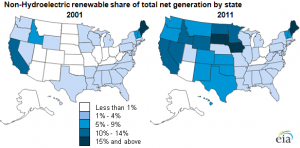WASHINGTON — Renewable sources produced 17 percent of all electricity generated in Iowa last year, up from 1 percent in 2001, according to a report issued this week by the U.S. Energy Information Administration.
The increase puts Iowa as No. 3 in terms of highest share of in-state energy production from wind, solar, geothermal and other renewable sources.
“Renewable energy is here to stay,” said Lisa Rivera Skubal, director of marketing for the Greater Cedar Valley Alliance, based in Waterloo. Skubal called the increase encouraging and attributed it to federal legislation and tax credits that encourage private investment in alternative energy. It’s a trend she hopes will continue.
“The more that the federal government can continue to support these renewable tax credits, we’re going to see more investment by international companies, in particular, that have embraced renewable energy generation in other countries,” Skubal said.
Iowa trailed behind South Dakota, where 21 percent of in-state electricity generation last year was from renewable sources. Maine produced the highest share of renewable energy in 2011, with 27 percent of its energy coming from sources other than oil, coal and gas. The figures do not include hydroelectric power — a renewable source derived from the flow of water — due to its high variability from year to year.
Diversification of utility companies’ energy portfolios also is cause for the rising emphasis on green energy, according to Bill M. Stigliani, the adviser to the provost on sustainability in the curriculum at the University of Northern Iowa. Stigliani pointed to Iowa’s Alternative Energy Production Law as critical in spurring the demand for green energy in the state.
Enacted in 1983, the law requires Iowa’s two investor-owned utilities to own or contract for a combined total of 105 megawatts of renewable energy generating capacity and associated energy production. Initially met with resistance, Stigliani said, utility companies soon came around to green energy.
“In the late 1990s, [utility companies] started building wind farms and they found out — to their surprise — that they were extremely reliable and produced a lot of electricity,” Stigliani said.
Wind power was the fastest growing alternative energy source nationwide, according to the Energy Information Administration. A report issued last spring by the American Council on Renewable Energy listed Iowa as second in the U.S. in installed wind capacity.
There’s room for further growth, Stigliani said.
“We’re only using a small percentage of what we could exploit,” Stigliani said. “They’re building new wind farms every year so it’s going to go up.”

